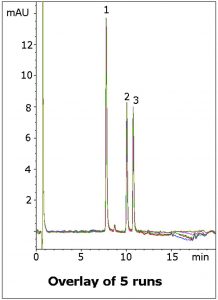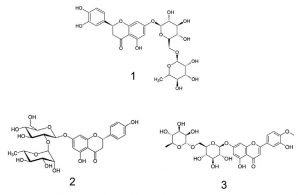Separation of Diosmin, Eriocitrin, and Naringin
In this method, three Glycosidic flavonoid standards are separated with good resolution. The Cogent Bidentate C18 2.o™ Column produces high efficiency peaks with reproducible retention (see figure overlay). Separation is also observed for a small impurity peak, eluting between peaks 1 and 2. This separation of standards could be applied to more complex samples such as citrus fruit extracts.


Peaks:
1. Eriocitrin
2. Naringin
3. Diosmin
Method Conditions
Column: Cogent Bidentate C18 2.o™, 2.2μm, 120Å
Catalog No.: 40218-05P-2
Dimensions: 2.1 x 50 mm
Mobile Phase:
—A: DI Water / 0.1% Formic Acid (v/v)
—B: Acetonitrile / 0.1% Formic Acid (v/v)
Gradient:
| Time (minutes) | %B |
| 0-1 | 10 |
| 15 | 30 |
| 16 | 30 |
| 17 | 10 |
Post Time: 3 minutes
Injection vol.: 0.2μL
Flow rate: 0.3mL/minute
Detection: UV @ 254 nm
Sample Preparation:
Stock Solutions: 1.0mg/mL Diosmin in DMSO diluent
————————1.0mg/mL Naringin in 1:1 DMSO : MeOH diluent
————————1.0mg/mL Eriocitrin in 1:1 DMSO : MeOH diluent.
Mixture: 0.02 mg/mL Diosmin,
————–0.7 mg/mL Eriocitrin,
————–0.2 mg/mL Naringin in 1:1 DMSO: MeOH diluent.
Note: Flavonoids are an important class of compounds found in citrus fruits. They have been shown to have anti-inflammatory, anti-allergic, anti-carcinogenic, antihypertensive and antiarthritic activities. Therefore, there is a need for a reliable HPLC method for their separation and quantitation.
Attachment
No 292 Glycosidic Flavonoids pdf 0.4 Mb Download File


